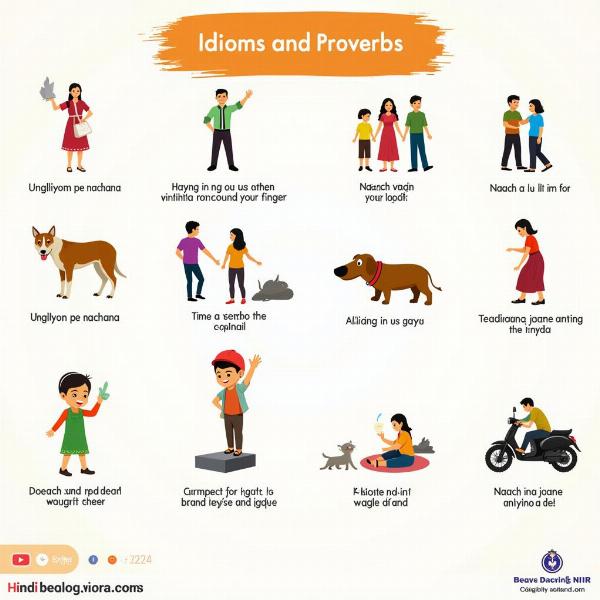Understanding how meaning is shaped in Hindi is crucial for effective communication and accurate translation. This involves not only grasping the literal definitions of words, but also appreciating the subtle nuances influenced by context, culture, and grammatical structures. “Shaping meaning in Hindi” requires a deep dive into the rich tapestry of the language, exploring its vocabulary, grammar, and cultural context.
The Building Blocks of Meaning: Vocabulary and Grammar
Hindi, like any language, relies on its vocabulary as the foundation of meaning. However, simply knowing the dictionary definition of a word isn’t enough. The same word can take on different meanings depending on the context in which it’s used. For example, the word “kal” can mean both “yesterday” and “tomorrow,” requiring careful attention to the surrounding sentence to determine the intended meaning.
Grammatical structures also play a significant role in shaping meaning. Word order, verb conjugations, and the use of postpositions all contribute to the overall message conveyed. The use of respectful forms of address, like “aap” instead of “tum,” adds another layer of meaning, reflecting the social dynamics between speakers.
Cultural Context: The Unspoken Language
Beyond vocabulary and grammar, cultural context is essential to understanding how meaning is crafted in Hindi. Cultural nuances, idioms, and proverbs deeply influence communication, often conveying meaning that goes beyond the literal words spoken. For instance, the concept of “izzat” (honor) is deeply ingrained in Indian culture, and understanding its significance is crucial to interpreting many conversations and interactions.
 Hindi Idioms and Proverbs
Hindi Idioms and Proverbs
Shaping Meaning in Translation: Navigating the Nuances
The complexities of shaping meaning in Hindi become especially evident in translation. Accurately conveying the intended message from Hindi to another language, or vice-versa, requires more than just substituting words. A skilled translator must consider the cultural context, the subtle nuances of vocabulary, and the grammatical intricacies to ensure the true meaning is preserved. This is where understanding the concept of “shaping meaning” becomes paramount. Direct translations often fail to capture the full essence of the original text, leading to misinterpretations or a loss of the intended impact.
What Makes Meaning in Hindi Unique?
Hindi’s rich history and diverse influences contribute to its unique way of shaping meaning. The language has absorbed elements from Sanskrit, Persian, Arabic, and English, creating a vibrant and complex linguistic landscape. This blend of influences adds layers of meaning to words and expressions, making Hindi a fascinating and challenging language to master.
Conclusion: Mastering the Art of Shaping Meaning
Shaping meaning in Hindi is a multifaceted process that goes beyond simply knowing the definitions of words. It requires a deep understanding of grammar, cultural context, and the interplay between these elements. Whether you are learning Hindi, translating text, or simply seeking to appreciate the richness of the language, grasping the art of shaping meaning is essential for effective communication and cultural understanding.
FAQ
- How does context influence meaning in Hindi? Context is crucial as it helps disambiguate words with multiple meanings and provides insight into the speaker’s intended message.
- Why are idioms and proverbs important for understanding Hindi? They often encapsulate cultural values and convey meaning beyond the literal words.
- What are the challenges of translating Hindi? Accurately capturing the nuances of meaning, considering cultural context, and finding equivalent expressions in the target language can be challenging.
- How can I improve my understanding of how meaning is shaped in Hindi? Immerse yourself in the language, engage with native speakers, and explore different forms of Hindi media.
- What is the role of grammar in shaping meaning? Grammar dictates how words are arranged and modified, impacting the overall meaning of a sentence.
- Why is understanding cultural context important? It allows for a deeper interpretation of communication, as it reveals underlying cultural values and beliefs.
- How can I learn more about Hindi vocabulary? Utilize dictionaries, online resources, and language learning apps.
Related Articles
- exogenic forces meaning in hindi
- reprogram meaning in hindi
- diastrophic forces meaning in hindi
- meaning of sankalp in hindi
Meaning-Hindi.in is your trusted partner for professional Hindi translation services. We specialize in various domains, including business, legal, technical, website localization, and educational translations. Whether you need accurate document translation or expert interpretation, our team of experienced linguists is dedicated to delivering high-quality language solutions tailored to your specific needs. Contact us today at [email protected] or call us at +91 11-4502-7584. Meaning-Hindi.in provides accurate and culturally sensitive translations to bridge the language gap and facilitate effective communication.